Tips Main Slot Online dengan Deposit 5000 untuk Pengalaman Seru!
Siapa bilang bermain slot online harus mengeluarkan modal besar? Dengan adanya deposit 5000, kamu sudah bisa merasakan pengalaman seru bermain slot online dengan peluang menang yang sama besar. Tidak perlu merasa khawatir dengan budget yang terbatas, karena ada banyak tips yang bisa kamu terapkan untuk tetap bisa menikmati permainan slot online tanpa harus mengeluarkan banyak uang.
Salah satu tips yang bisa kamu lakukan adalah memilih mesin slot yang tepat. Setiap mesin slot memiliki karakteristik yang berbeda, seperti jumlah payline, tema, dan bonus yang ditawarkan. Sebelum memulai permainan, pastikan kamu telah membaca dan memahami semua informasi mengenai mesin slot yang akan kamu mainkan. Pilihlah mesin slot yang memiliki payline yang tidak terlalu banyak, karena semakin banyak payline, semakin besar taruhan yang harus kamu keluarkan. Selain itu, pilihlah mesin slot dengan tema yang menarik dan bonus yang menarik juga, agar permainan menjadi lebih seru.
Selain itu, kamu juga bisa memanfaatkan bonus dan promosi yang ditawarkan oleh situs slot online. Banyak situs slot online yang menawarkan bonus deposit 5000 yang bisa kamu gunakan untuk bermain. Selain itu, ada juga promosi seperti cashback atau free spin yang bisa kamu manfaatkan untuk meningkatkan peluang menang. Jangan ragu untuk memanfaatkan semua bonus dan promosi yang ditawarkan, karena hal ini akan membantu kamu menghemat budget dan tetap bisa menikmati permainan slot online dengan deposit 5000.
Nikmati Serba-Serbi Slot Online Deposit 5000 Tanpa Takut Lepas Kendali Keuangan!
Salah satu keuntungan dari bermain slot online dengan deposit 5000 adalah kamu tidak perlu khawatir dengan keuanganmu. Dengan modal yang terbatas, kamu akan lebih berhati-hati dalam mengatur budget dan tidak terlalu berambisi untuk menang besar. Ini juga akan membantu kamu untuk tetap mengontrol keuanganmu dan tidak terjebak dalam permainan yang tidak sehat.
Selain itu, bermain slot online dengan deposit 5000 juga memberikan kesempatan yang sama untuk menang. Banyak pemain yang berpikir bahwa semakin besar taruhan yang dikeluarkan, semakin besar pula peluang untuk menang. Namun, hal ini tidak sepenuhnya benar. Dengan modal 5000, kamu bisa memilih mesin slot yang tepat dan memanfaatkan semua bonus dan promosi yang ditawarkan, sehingga peluang untuk menang tetap sama besar seperti bermain dengan modal yang lebih besar.
Tak perlu ragu untuk mencoba bermain slot online dengan deposit 5000. Tidak hanya bisa menikmati pengalaman seru bermain slot online, kamu juga bisa mengontrol keuanganmu dengan lebih baik dan tetap memiliki peluang yang sama untuk menang. Jangan lupa untuk selalu memilih mesin slot yang tepat dan memanfaatkan semua bonus dan promosi yang ditawarkan oleh situs slot online. Selamat bermain dan semoga beruntung!

